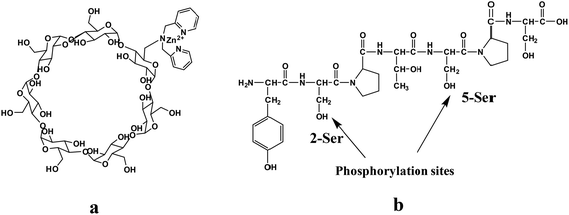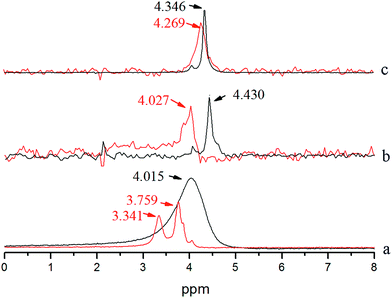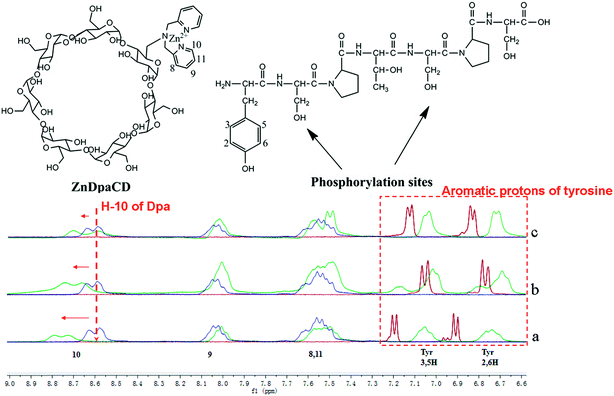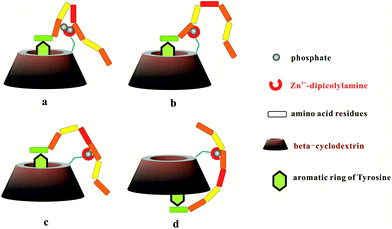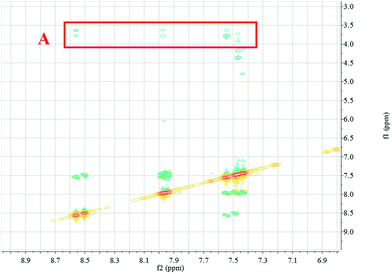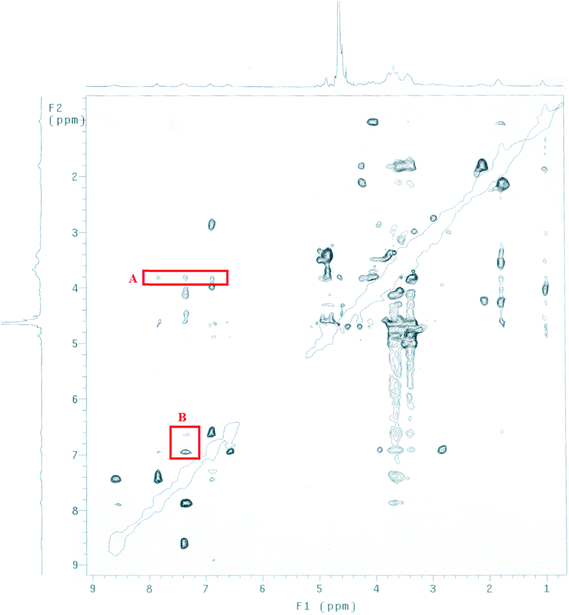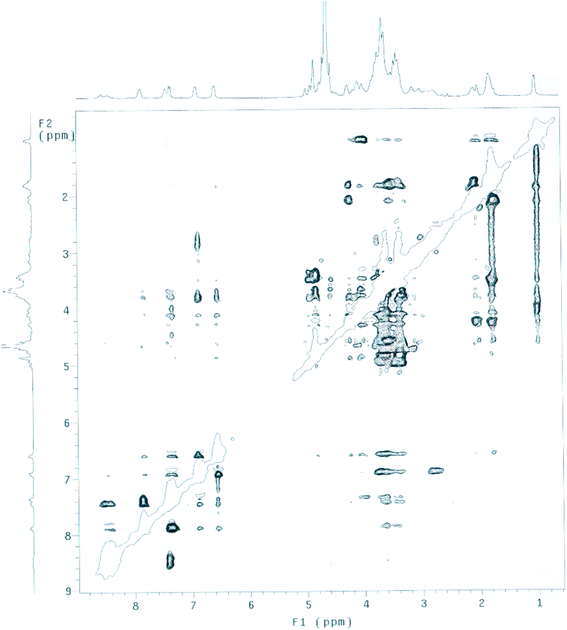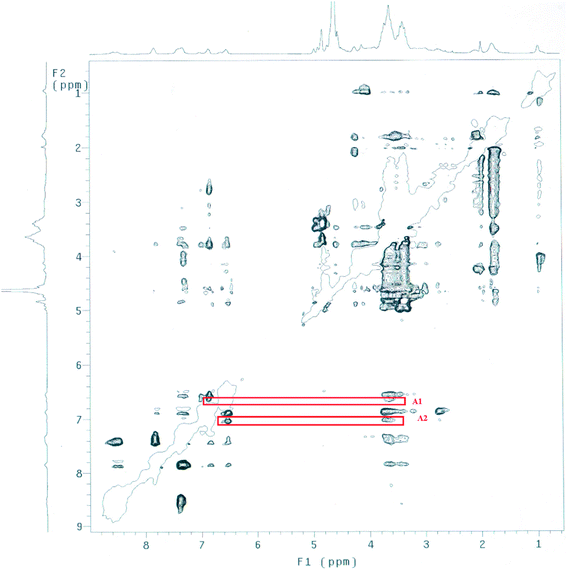Study on the association between CTD peptides and zinc(II)-dipicolylamine appended beta-cyclodextrin
Saihui Zhang*ab,
Yantao Shia,
Wei Wanga and
Zhi Yuan*a
aKey Laboratory of Functional Polymer Materials of Ministry of Education, Institute of Polymer Chemistry, Nankai University and Collaborative Innovation Center of Chemical Science and Engineering, Nankai University, Tianjin 300071, China. E-mail: ZhangSH_TJPU@126.com; zhiy@nankai.edu.cn
bState Key Laboratory of Separation Membranes and Membrane Processes, School of Environmental and Chemical Engineering, Tianjin Polytechnic University, Tianjin 300387, China
First published on 16th September 2015
Abstract
Association between zinc(II)-dipicolylamine (ZnDpa) appended beta-cyclodextrin (beta-CD) and CTD (carboxy-terminal domain of RNA polymerase II) peptides with different phosphorylation patterns was studied by isothermal titration calorimetry (ITC) and nuclear magnetic resonance (NMR). The receptor displayed association constants of 6.52 × 103 to 1.49 × 105 towards the phosphorylated peptides, which are 16 to 72 times higher than that of ZnDpa, indicating the involvement of molecular recognition of beta-CD. NMR results confirm the involvement of beta-CD in the association, i.e. the aromatic ring on the tyrosine of the peptide was included in the cavity of CD, while the inclusion manners are different among the peptides.
Introduction
Recognition of oligopeptides using synthetic receptors is a preliminary step for protein-targeted biotechnology including bioimaging and drug development.1,2 Considerable research effort has been devoted to this subject during the past two decades. Part of the effort has been focused on phosphorylated peptides, because phosphorylation is the most important post-transcriptional modification of protein, and one-third of proteins are phosphorylated.3A typical characteristic of phosphorylated peptides is the –PO42− group, which could be efficiently associated by coordination-based receptor. The well-developed bi-nuclear Zn2+-based receptors4–6 have been reported to effectively associate phosphorylated peptides with association constants in the range of 105 to 108. Notably, Hamachi and coworkers demonstrate the high selectivity of ZnDpa towards phosphate.4 Simth and coworkers employ ZnDpa in combination with a near-infrared fluorophore for in vivo optical imaging.7 Mohr and coworkers explored a fluorescent naphthalimide chemosensor for ATP bearing a dipicolylamine group complexed with a Zn(II) metal as a receptor moiety.8 Ngo et al. reviewed studies employing ZnDpa as phosphate recognition moiety.9 Though ZnDpa associate phosphate with high selectivity, a single coordination force cannot afford the receptors with selectivity for different phosphorylated species.
Bearing hydrophobic cavity and hydrophilic shell, beta-CD is widely employed as host for complexation with different guest molecules via hydrophobic inclusion. Breslow,10 Inoue11 and Liu12 et al. make great contribution to molecular recognition properties of beta-CD and its derivatives, furthermore, these compounds were employed as enzyme mimics for hydrolysis of ester13 and amide14 as well as construction of supramolecular structures.15
Combining coordination of ZnDpa and hydrophobic inclusion of beta-CD, in this study, zinc(II)-dipicolylamine appended beta-CD (ZnDpaCD) was synthesized (Fig. 1a), and its association with CTD (carboxy-terminal domain of RNA polymerase II) peptides with different phosphorylation patterns (Fig. 1b) was studied.
Experimental section
Materials
Beta-CD was recrystallized from distilled water twice, and dried in vaccum. 4-Toluene sulfonyl chloride was recrystallized from petroleum ether. DMF of analytical purity was distilled under reduced pressure. Peptides with purity >98% were purchased from GL Biochem (Shanghai) Ltd. All other reagents were commercially available analytical grade and used as received.Instrumentation
31P NMR and 2D 1H NMR spectra were recorded on a Varian Mercury/VX 300 and Bruker AV600, 1D 1H NMR spectra was performed on VARIAN UNITY-plus 400. Matrix-assisted laser desorption/ionization time-of-flight mass spectrometry (MALDI-TOF-MS) was conducted with an AUTOFLEX-III LRF200-CID MALDI-TOF mass spectrometer (Bruker Daltonics, Germany). ITC measurement was performed using VP-ITC.NMR samples preparation
For 31P NMR and 1H NMR experiments, samples were dissolved in D2O, and the pH was adjusted to 7 by NaOH/D2O solution.ITC measurements
ITC measurements were conducted at 298 K. The receptor and the peptides were dissolved in 50 mM HEPES pH = 7.2. Peptides were loaded in the cell, while receptor was loaded in the syringe. To get more data points and facilitate data fitting, the initial titrations contain smaller injection volume. To eliminate the influence of titrant diffusion at the tip of the syringe, a much smaller volume of first injection was employed and the data was discarded in curve fitting. The titration contains an initial injection of 2 μL followed by 5 injections of 6 μL followed by 5 injections of 8 μL followed by 22 injections of 10 μL. Heat of dilution was subtracted from titration data before curve-fitting in origin. For titration of ZnDpaCD to bis-phosphorylated CTD peptide, the concentrations were 5 mM for ZnDpaCD and 100 μM for the peptide. For titration of ZnDpaCD to 5-Ser-phosphorylated peptide, the concentrations were 5 mM for ZnDpaCD and 500 μM for the peptide. For titration of ZnDpaCD to 2-Ser-phosphorylated peptide, the concentrations were 10 mM for ZnDpaCD and 500 μM for the peptide. For titration of ZnDpaCD to non-phosphorylated peptide, the concentrations were 10 mM for ZnDpaCD and 100 μM for the peptide.Synthesis of 6-tosylated cyclodextrin (6-Tos-CD)16
At 6 °C, 15 g of dry β-cyclodextrin was added to 150 mL distilled water, then 1.7 g NaOH in 15 mL distilled water was added under stirring. When the solution was homogeneous, 2.52 g 4-toluene sulfonyl chloride in 10 mL acetonitrile was quickly added, and white precipitate appeared immediately. The reaction was kept at 25 °C for another 2 hour, then the mixture was filtered, and the filtrate was neutralized to pH 7.6 with 1 M HCl and kept at 4 °C overnight. The crude product was obtained by filtration, and the product was obtained by recrystallizing the crude from water. After dried in vacuum for 24 hours, 1.488 g 6-tosylated cyclodextrin was obtained, yield 8.6%. 1H NMR (400 MHz, DMSO): δ 7.75 (d, 2H), 7.43 (d, 2H), 5.95–5.49 (m, 14H), 4.80 (d, 7H), 4.55–4.26 (m, 6H), 3.80–3.42 (m, 102H including water peak), 2.43 (s, 3H). MALDI-TOF: m/z C49H76O37S calculated for [M + Na+] 1311.37, found 1311.41.Synthesis of 6-dipicolylamine-appended cyclodextrin (DpaCD)
Under N2 atmosphere, 100 mg 6-tos-CD and 500 mg dipicolylamine were added to 1 mL DMF, the reaction was kept for 24 hours at 90 °C. After cooled to room temperature, the solution was precipitated with 100 mL acetone, then centrifuged at 5000 rpm for 10 min. After filtration, the precipitate was dissolved in 2 mL distilled water, and precipitated with 60 mL acetone, then centrifuged at 5000 rpm for 20 min, these steps were repeated once, then the product was obtained as a pale yellow solid. 1H NMR (400 MHz, DMSO) δ 8.44 (d, 2H), 7.73 (t, 2H), 7.53 (d, 2H), 7.38–7.04 (m, 2H), 6.12–5.35 (m, 85H including water peak), 4.83 (d, 7H), 4.74–4.35 (m, 6H), 3.90 (d, 3H), 3.77–3.49 (m, 27H), MALDI-TOF: m/z calculated for C54H79N3O34 [M + H+] 1314.46, found 1314.76.Synthesis of 6-Zn2+-dipicolylamine-appended cyclodextrin (ZnDpaCD)
When DpaCD was dried, it difficult to redissolve in H2O, thus, DpaCD without drying was used. DpaCD and Zn(NO3)2·6H2O with molar ratio of 1![[thin space (1/6-em)]](https://www.rsc.org/images/entities/char_2009.gif) :
:![[thin space (1/6-em)]](https://www.rsc.org/images/entities/char_2009.gif) 2 was dissolved in 1.2 mL H2O, after 2 hour, the solution was precipitated with 30 mL acetone, then centrifuged at 8000 rpm for 30 min, after vacuum dried, the product was obtain as a pale yellow crystalline solid, yield 66.5%. 1H NMR (400 MHz, DMSO) δ 8.60 (d, 2H), 8.04 (dd, J = 33.0, 2H), 7.58 (d, 3H), 5.89 (dd, 14H), 4.84 (dd, 7H), 4.53 (dd, 7H), 4.13 (s, 1H), 3.92–3.41 (m, 113H including water peak); ESI: calculated for C54H79N3O34Zn2+, [M/2] 689.79, found 689.69.
2 was dissolved in 1.2 mL H2O, after 2 hour, the solution was precipitated with 30 mL acetone, then centrifuged at 8000 rpm for 30 min, after vacuum dried, the product was obtain as a pale yellow crystalline solid, yield 66.5%. 1H NMR (400 MHz, DMSO) δ 8.60 (d, 2H), 8.04 (dd, J = 33.0, 2H), 7.58 (d, 3H), 5.89 (dd, 14H), 4.84 (dd, 7H), 4.53 (dd, 7H), 4.13 (s, 1H), 3.92–3.41 (m, 113H including water peak); ESI: calculated for C54H79N3O34Zn2+, [M/2] 689.79, found 689.69.
Results and discussion
mRNA transcription is generally mediated by CTD of RNA polymerase II.17 The binding of specific processing factors depends on the phosphorylation pattern of the CTD, which changes during the transcription cycle.18 The CTD consists of heptapeptide repeats of the consensus sequence Tyr1-Ser2-Pro3-Thr4-Ser5-Pro6-Ser7, with phosphorylation mainly occurs at Ser2 and Ser5.19 Receptors that associate CTD with selectivity may function as regulator of the transcription process.Fujita and coworkers synthesized DpaCD by reaction between amine substituted beta-CD and 2-pyridinecarboxaldehyde,14 in comparison with this strategy, substituting 6-Tos-CD with dipicolylamine should afford better yield, because amine substituted beta-CD suffers from low yield.
When ZnDpaCD was added to peptide solutions, coordination between ZnDpa and phosphates of the peptides occurs as revealed by the chemical shift in 31P NMR spectra (Fig. 2).
ITC results indicate the association constants follow the order of Y2p5pS > Y5pS > Y2pS (Table 1). Notably, the association constants from ZnDpaCD are significantly larger than that from ZnDpa, indicating the beta-CD moiety of ZnDpaCD cooperatively involved in the association. Binuclear coordination-type receptors for phosphorylated peptides show association constants in the range of 105 to 108, though ZnDpaCD contains a single coordination site, it shows comparable affinity in comparison with some binuclear coordination-type receptor.
| Receptor | Peptide | K/M−1 | ΔH/cal mol−1 | ΔS/cal mol−1 K−1 |
|---|---|---|---|---|
| a ‘—’ denote that the enthalpy change is too small to be accurately fitted in origin. YS denote non-phosphorylated CTD peptide Tyr1-Ser2-Pro3-Thr4-Ser5-Pro6-Ser7. The titrations were conducted at 298 K. | ||||
| ZnDpaCD | Y2pS | 6.52 × 103 | 390.7 | 18.8 |
| ZnDpaCD | Y5pS | 3.16 × 104 | 752.1 | 23.1 |
| ZnDpaCD | Y2p5pS | 1.49 × 105 | 1522 | 28.8 |
| ZnDpaCD | YS | — | — | — |
| ZnDpa | Y2pS | 392 | 4.62 × 103 | 27.2 |
| ZnDpa | Y5pS | 435 | 4.74 × 103 | 28.1 |
| ZnDpa | Y2p5pS | 4.93 × 103 | 2.89 × 103 | 26.4 |
| ZnDpa | YS | — | — | — |
1H NMR was used to study the association in detail (Fig. 3). Upon association, signal from H-10 of dipicolylamine broaden and shifts downfield, indicating the involvement of ZnDpa in the coordination. On the other hand, signal from aromatic group of tyrosine on the peptide broaden and shifts upfield, indicating the aromatic ring of tyrosine is included in the cavity of beta-CD. Notably, for Ser5 phosphorylated peptide, the aromatic signal splits into two groups, i.e. 7.2 ppm, 6.8 ppm and 7.0 ppm, 6.7 ppm, indicating two different inclusion modes. This is attributed to the asymmetric structure of ZnDpaCD, and aromatic ring of tyrosine could enter the cavity from ether the narrow rim or the wider rim. The overall association modes is illustrated in Fig. 4.
The inclusion modes are further proved by 2D ROESY spectrum. Fig. 5 is ROESY spectrum of ZnDpaCD. Signal in A region is the cross peaks between aromatic protons of Dpa and protons of CD. Considering ZnDpa moiety is highly hydrated, it cannot be self-included in the cavity of CD. Thus, the cross peaks are inferred to be from H-6 of CD rather than H-3 and H-5.
Fig. 6 is ROESY spectrum of Y2p5pS and ZnDpaCD in 1![[thin space (1/6-em)]](https://www.rsc.org/images/entities/char_2009.gif) :
:![[thin space (1/6-em)]](https://www.rsc.org/images/entities/char_2009.gif) 1 molar ratio. Signals in region A indicate the spatial proximity of 6 H of beta-CD and dipicolylamine as well as tyrosine. Considering the aromatic ring of tyrosine is included in the cavity and only H-3,5 of tyrosine display cross peaks with 6 H of CD, the inclusion mode is inferred to be insertion of phenol–OH side of tyrosine from the narrow rim of CD. Signals in region B indicate the spatial proximity of dipicolylamine and tyrosine. Combining the spatial proximity information, the association mode is illustrated in Fig. 4a.
1 molar ratio. Signals in region A indicate the spatial proximity of 6 H of beta-CD and dipicolylamine as well as tyrosine. Considering the aromatic ring of tyrosine is included in the cavity and only H-3,5 of tyrosine display cross peaks with 6 H of CD, the inclusion mode is inferred to be insertion of phenol–OH side of tyrosine from the narrow rim of CD. Signals in region B indicate the spatial proximity of dipicolylamine and tyrosine. Combining the spatial proximity information, the association mode is illustrated in Fig. 4a.
Fig. 7 is ROESY spectrum of Y2pS and ZnDpaCD in 1![[thin space (1/6-em)]](https://www.rsc.org/images/entities/char_2009.gif) :
:![[thin space (1/6-em)]](https://www.rsc.org/images/entities/char_2009.gif) 1 molar ratio. The signals are similar to that of Y2p5pS/ZnDpaCD, except for more intense cross peaks from aromatic protons of Dpa and tyrosine, indicating the similar association mode (Fig. 4b).
1 molar ratio. The signals are similar to that of Y2p5pS/ZnDpaCD, except for more intense cross peaks from aromatic protons of Dpa and tyrosine, indicating the similar association mode (Fig. 4b).
Fig. 8 is ROESY spectrum of Y5pS and ZnDpaCD in 1![[thin space (1/6-em)]](https://www.rsc.org/images/entities/char_2009.gif) :
:![[thin space (1/6-em)]](https://www.rsc.org/images/entities/char_2009.gif) 1 molar ratio. In comparison with the above two spectra, new signals in region A1 and A2 appear, indicating tyrosine is included in CD pocket in another different manner. Additionally, these signals do not show cross peaks with Dpa, indicating tyrosine is far away from Dpa. Combining the spatial proximity information, the association modes is illustrated in Fig. 4c and d.
1 molar ratio. In comparison with the above two spectra, new signals in region A1 and A2 appear, indicating tyrosine is included in CD pocket in another different manner. Additionally, these signals do not show cross peaks with Dpa, indicating tyrosine is far away from Dpa. Combining the spatial proximity information, the association modes is illustrated in Fig. 4c and d.
Conclusions
In summary, ZnDpaCD associate phosphorylated CTD peptides through coordination in combination with hydrophobic inclusion. The inclusion manner of tyrosine into hydrophobic cavity of CD are different depending on the phosphorylation pattern of the peptides. ZnDpaCD shows selectivity towards the peptides, i.e. the association constants ranging from 6.52 × 103 to 1.49 × 105, and follows the order of Y2p5pS > Y5pS > Y2pS. Though the receptor discriminates bis-phosphorylated peptides and mono-phosphorylated peptides, but the selectivity for different mono-phosphorylated peptides is not high.Notes
The authors declare no competing financial interest.Acknowledgements
This work is supported by the National Natural Science Foundation of China (21104034, 51273094) and PCSIRT (IRT1257).References
- C. H. Battle and J. Jayawickramarajah, Supramolecular Approaches for Inhibition of Protein–Protein and Protein–DNA Interactions, in Supramol. Chem., John Wiley & Sons, Ltd, 2012 Search PubMed.
- G. Lund, S. Dudkin, D. Borkin, W. Ni, J. Grembecka and T. Cierpicki, Inhibition of CDC25B phosphatase through disruption of protein–protein interaction, ACS Chem. Biol., 2015, 10(2), 390–394 CrossRef CAS PubMed.
- Y.-H. Wong, T.-Y. Lee, H.-K. Liang, C.-M. Huang, T.-Y. Wang, Y.-H. Yang, C.-H. Chu, H.-D. Huang, M.-T. Ko and J.-K. Hwang, KinasePhos 2.0: a web server for identifying protein kinase-specific phosphorylation sites based on sequences and coupling patterns, Nucleic Acids Res., 2007, 35(2), W588–W594 CrossRef PubMed.
- A. Ojida, Y. Mito-oka, M.-a. Inoue and I. Hamachi, First artificial receptors and chemosensors toward phosphorylated peptide in aqueous solution, J. Am. Chem. Soc., 2002, 124(22), 6256–6258 CrossRef CAS PubMed.
- A. Ojida, Y. Mito-oka, K. Sada and I. Hamachi, Molecular Recognition and Fluorescence Sensing of Monophosphorylated Peptides in Aqueous Solution by Bis(zinc(II)−dipicolylamine)-Based Artificial Receptors, J. Am. Chem. Soc., 2004, 126(8), 2454–2463 CrossRef CAS PubMed.
- A. Grauer, A. Riechers, S. Ritter and B. König, Synthetic Receptors for the Differentiation of Phosphorylated Peptides with Nanomolar Affinities, Chem.–Eur. J., 2008, 14(29), 8922–8927 CrossRef CAS PubMed.
- B. A. Smith, W. J. Akers, W. M. Leevy, A. J. Lampkins, S. Xiao, W. Wolter, M. A. Suckow, S. Achilefu and B. D. Smith, Optical imaging of mammary and prostate tumors in living animals using a synthetic near infrared zinc (II)-dipicolylamine probe for anionic cell surfaces, J. Am. Chem. Soc., 2009, 132(1), 67–69 CrossRef PubMed.
- A. J. Moro, P. J. Cywinski, S. Körsten and G. J. Mohr, An ATP fluorescent chemosensor based on a Zn (II)-complexed dipicolylamine receptor coupled with a naphthalimide chromophore, Chem. Commun., 2010, 46(7), 1085–1087 RSC.
- H. T. Ngo, X. Liu and K. A. Jolliffe, Anion recognition and sensing with Zn (II)–dipicolylamine complexes, Chem. Soc. Rev., 2012, 41(14), 4928–4965 RSC.
- R. Breslow, S. Halfon and B. Zhang, Molecular recognition by cyclodextrin dimers, Tetrahedron, 1995, 51(2), 377–388 CrossRef CAS.
- M. V. Rekharsky and Y. Inoue, Complexation and chiral recognition thermodynamics of 6-amino-6-deoxy-β-cyclodextrin with anionic, cationic, and neutral chiral guests: counterbalance between van der Waals and coulombic interactions, J. Am. Chem. Soc., 2002, 124(5), 813–826 CrossRef CAS PubMed.
- Y. Liu, B.-H. Han, S.-X. Sun, T. Wada and Y. Inoue, Molecular recognition study on supramolecular systems 20. Molecular recognition and enantioselectivity of aliphatic alcohols by L-tryptophan-modified β-cyclodextrin, J. Org. Chem., 1999, 64(5), 1487–1493 CrossRef CAS PubMed.
- B. Zhang and R. Breslow, Ester hydrolysis by a catalytic cyclodextrin dimer enzyme mimic with a metallobipyridyl linking group, J. Am. Chem. Soc., 1997, 119(7), 1676–1681 CrossRef CAS.
- J.-M. Yan, M. Atsumi, D.-Q. Yuan and K. Fujita, Synergistic effect of cyclodextrin-based binuclear complexes in the hydrolysis of amide, Tetrahedron Lett., 2000, 41(11), 1825–1828 CrossRef CAS.
- Q. Wang, Y. Chen and Y. Liu, Supramolecular ternary polymer mediated by cucurbituril and cyclodextrin, Polym. Chem., 2013, 4(15), 4192–4198 RSC.
- R. C. Petter, J. S. Salek, C. T. Sikorski, G. Kumaravel and F. T. Lin, Cooperative binding by aggregated mono-6-(alkylamino)-beta-cyclodextrins, J. Am. Chem. Soc., 1990, 112(10), 3860–3868 CrossRef CAS.
- D. Eick and M. Geyer, The RNA polymerase II carboxy-terminal domain (CTD) code, Chem. Rev., 2013, 113(11), 8456–8490 CrossRef CAS PubMed.
- Y. Luo, S. Yogesha, J. R. Cannon, W. Yan, A. D. Ellington, J. S. Brodbelt and Y. Zhang, novel modifications on C-terminal domain of RNA polymerase II can fine-tune the phosphatase activity of Ssu72, ACS Chem. Biol., 2013, 8(9), 2042–2052 CrossRef CAS PubMed.
- A. Meinhart, T. Kamenski, S. Hoeppner, S. Baumli and P. Cramer, A structural perspective of CTD function, Genes Dev., 2005, 19(12), 1401–1415 CrossRef CAS PubMed.
- S. Zhang, L. Han, C.-g. Li, J. Wang, W. Wang, Z. Yuan and X. Gao, Synthetic receptor and its association with CTD peptides, Tetrahedron, 2012, 68(10), 2357–2362 CrossRef CAS PubMed.
| This journal is © The Royal Society of Chemistry 2015 |

